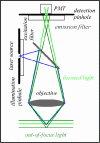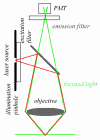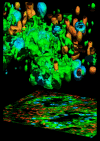Multi-photon excitation microscopy
- PMID: 16756664
- PMCID: PMC1550243
- DOI: 10.1186/1475-925X-5-36
Multi-photon excitation microscopy
Abstract
Multi-photon excitation (MPE) microscopy plays a growing role among microscopical techniques utilized for studying biological matter. In conjunction with confocal microscopy it can be considered the imaging workhorse of life science laboratories. Its roots can be found in a fundamental work written by Maria Goeppert Mayer more than 70 years ago. Nowadays, 2PE and MPE microscopes are expected to increase their impact in areas such biotechnology, neurobiology, embryology, tissue engineering, materials science where imaging can be coupled to the possibility of using the microscopes in an active way, too. As well, 2PE implementations in noninvasive optical bioscopy or laser-based treatments point out to the relevance in clinical applications. Here we report about some basic aspects related to the phenomenon, implications in three-dimensional imaging microscopy, practical aspects related to design and realization of MPE microscopes, and we only give a list of potential applications and variations on the theme in order to offer a starting point for advancing new applications and developments.
Figures











References
-
- Diaspro A. New World Microscopy. IEEE Engineering In Medicine And Biology Magazine. 1996;15:29–100. doi: 10.1109/MEMB.1996.482790. - DOI
-
- Beltrame F, Bianco B, Castellaro G, Diaspro A. Fluorescence, Absorption, Phase-contrast, Holographic and Acoustical Cytometries of Living Cells. In: Chiabrera A, editor. Interactions between Electromagnetic Fields and Cells. Vol. 97. NATO ASI Series, Plenum Press Publishing, New York and London; 1985. pp. 483–498.
-
- Arndt-Jovin DJ, Nicoud RM, Kaufmann J, Jovin TM. Fluorescence digital-imaging microscopy in cell biology. Science. 1985;230:13330–13335. - PubMed
-
- Fay FS, Carrington W, Fogarty KE. Three-dimensional molecular distribution in single cells analyzed using the digital imaging microscope. J Microsc. 1989;153:133–149. - PubMed
-
- Periasamy A. Methods in Cellular Imaging. Oxford University Press, New York; 2000.
Publication types
MeSH terms
LinkOut - more resources
Full Text Sources
Other Literature Sources
Research Materials

